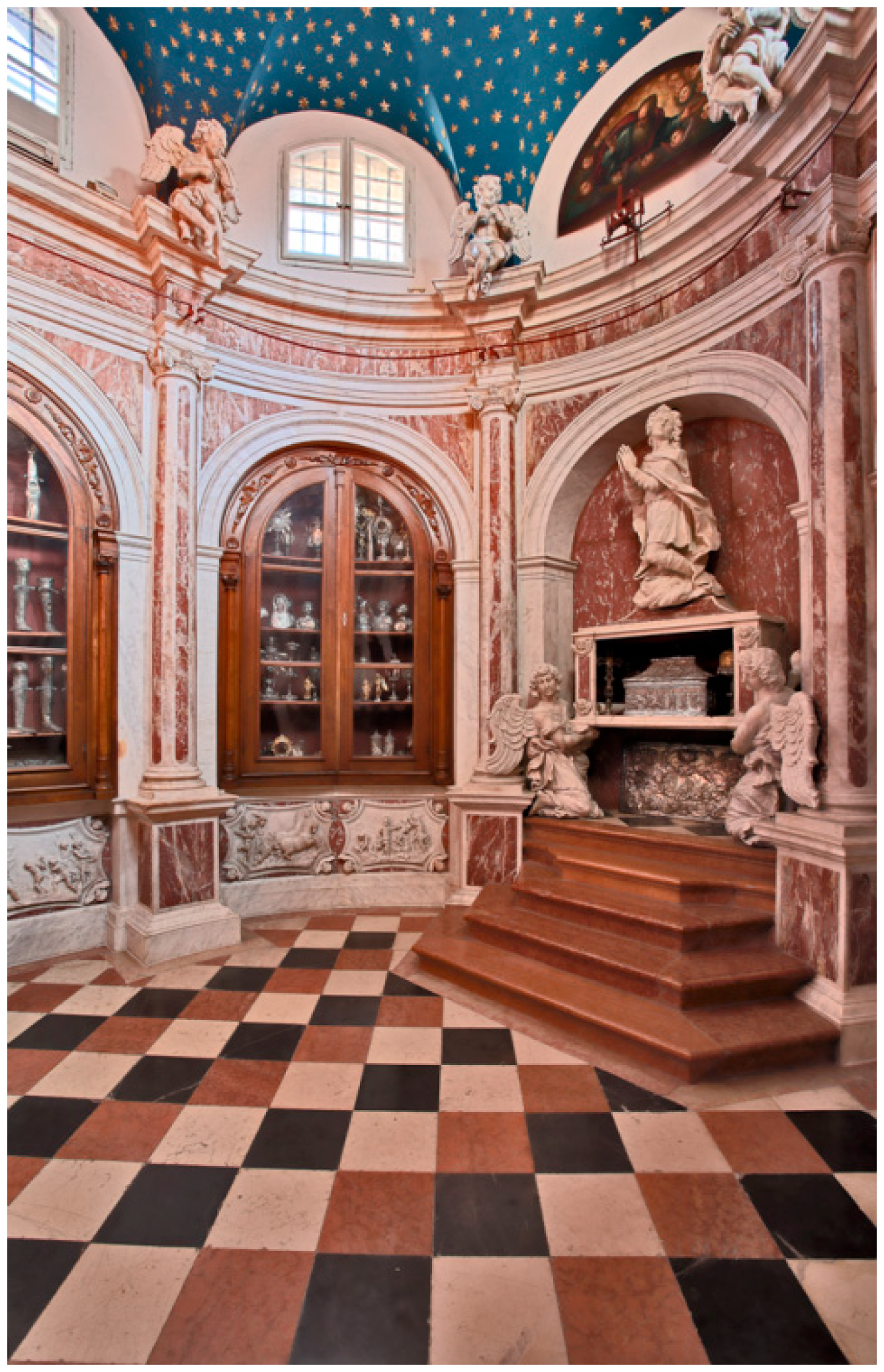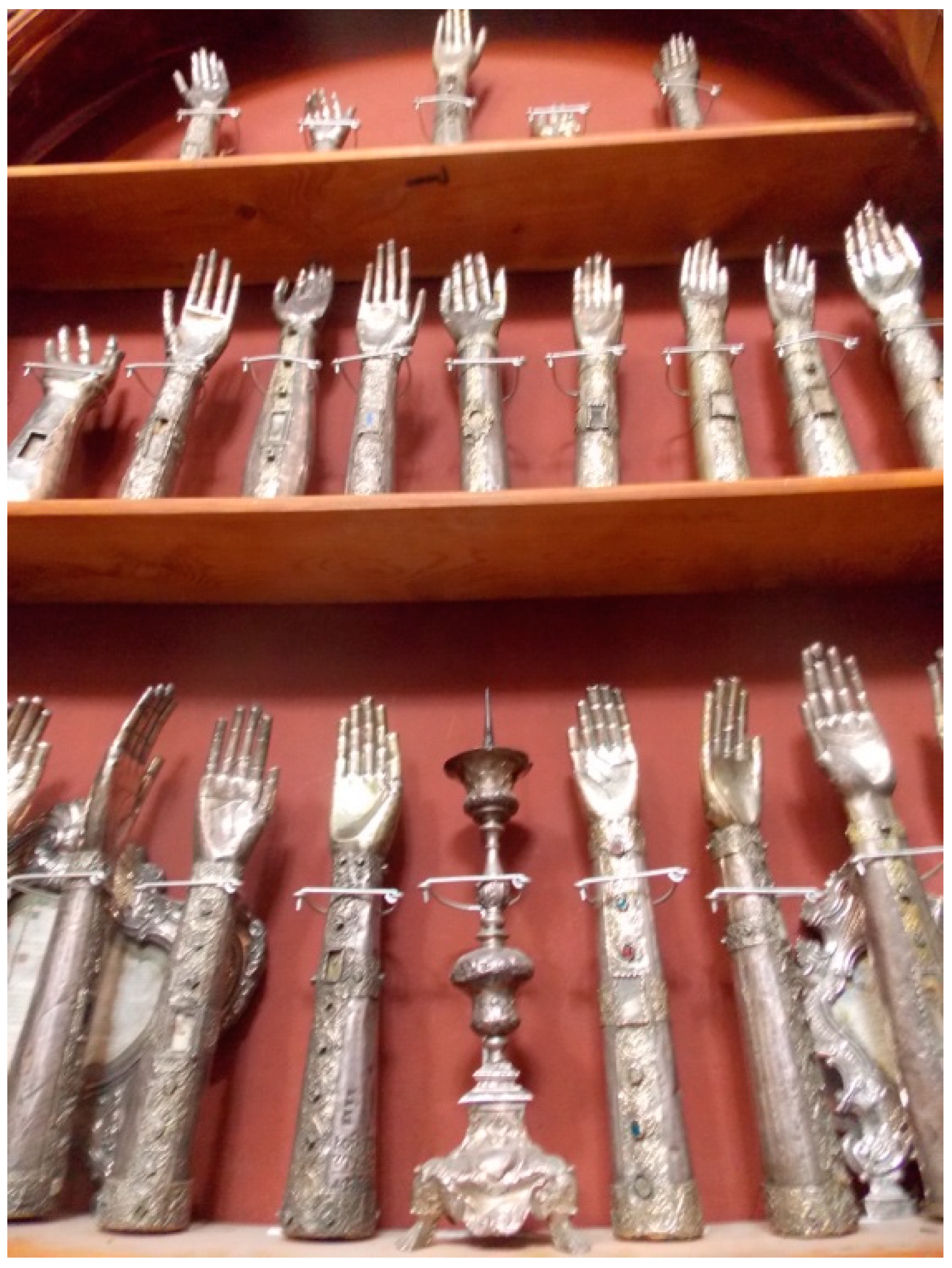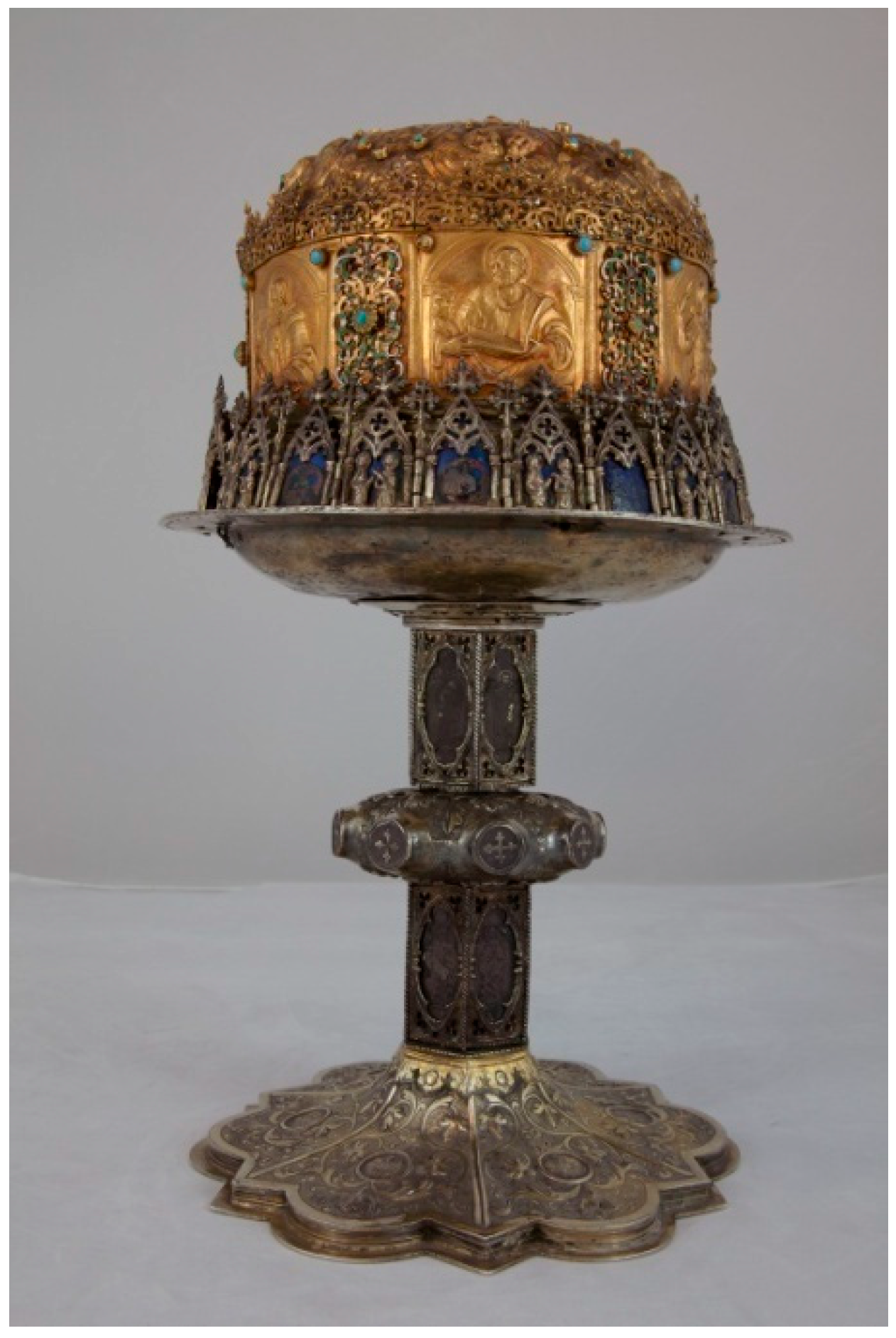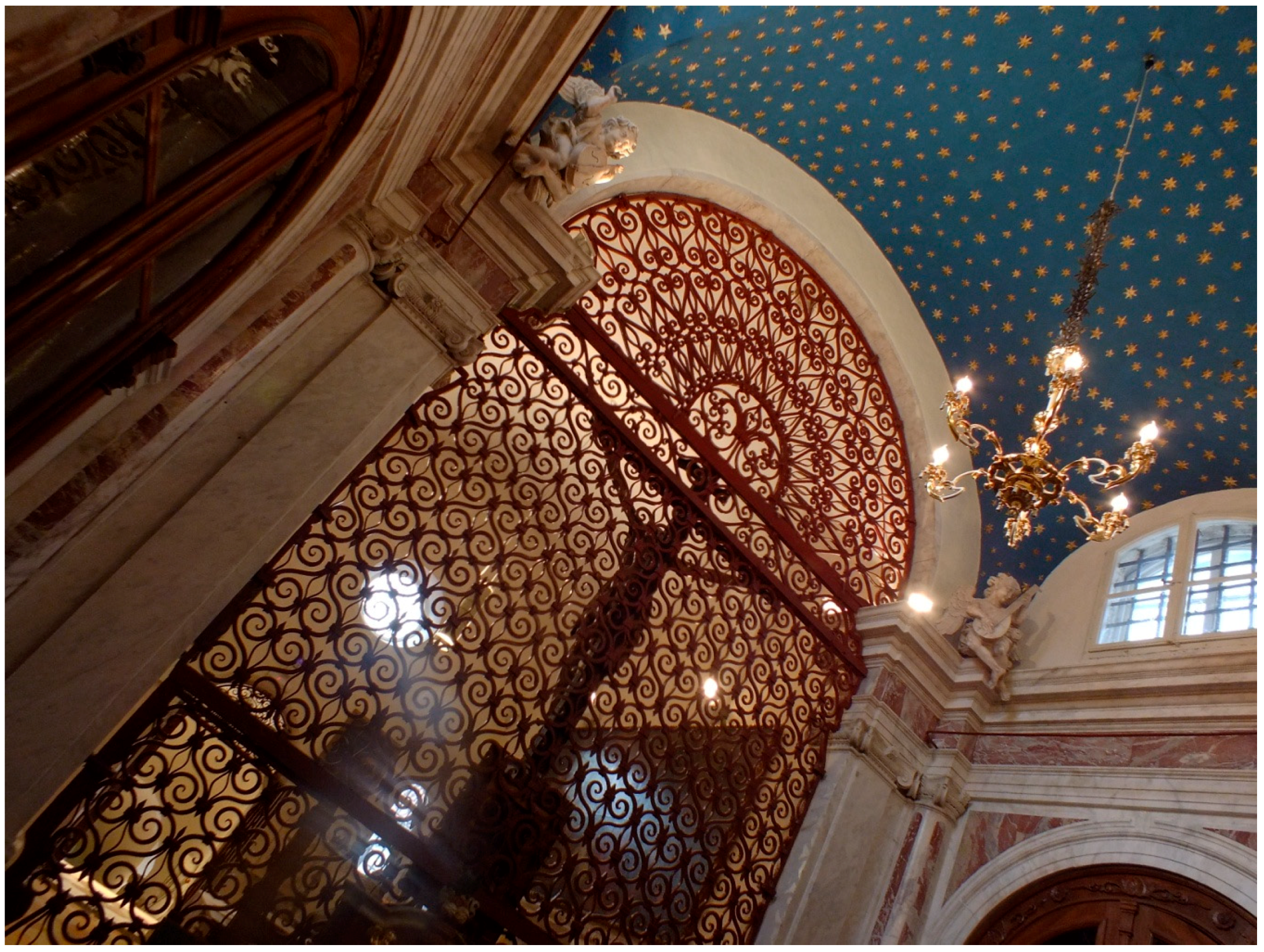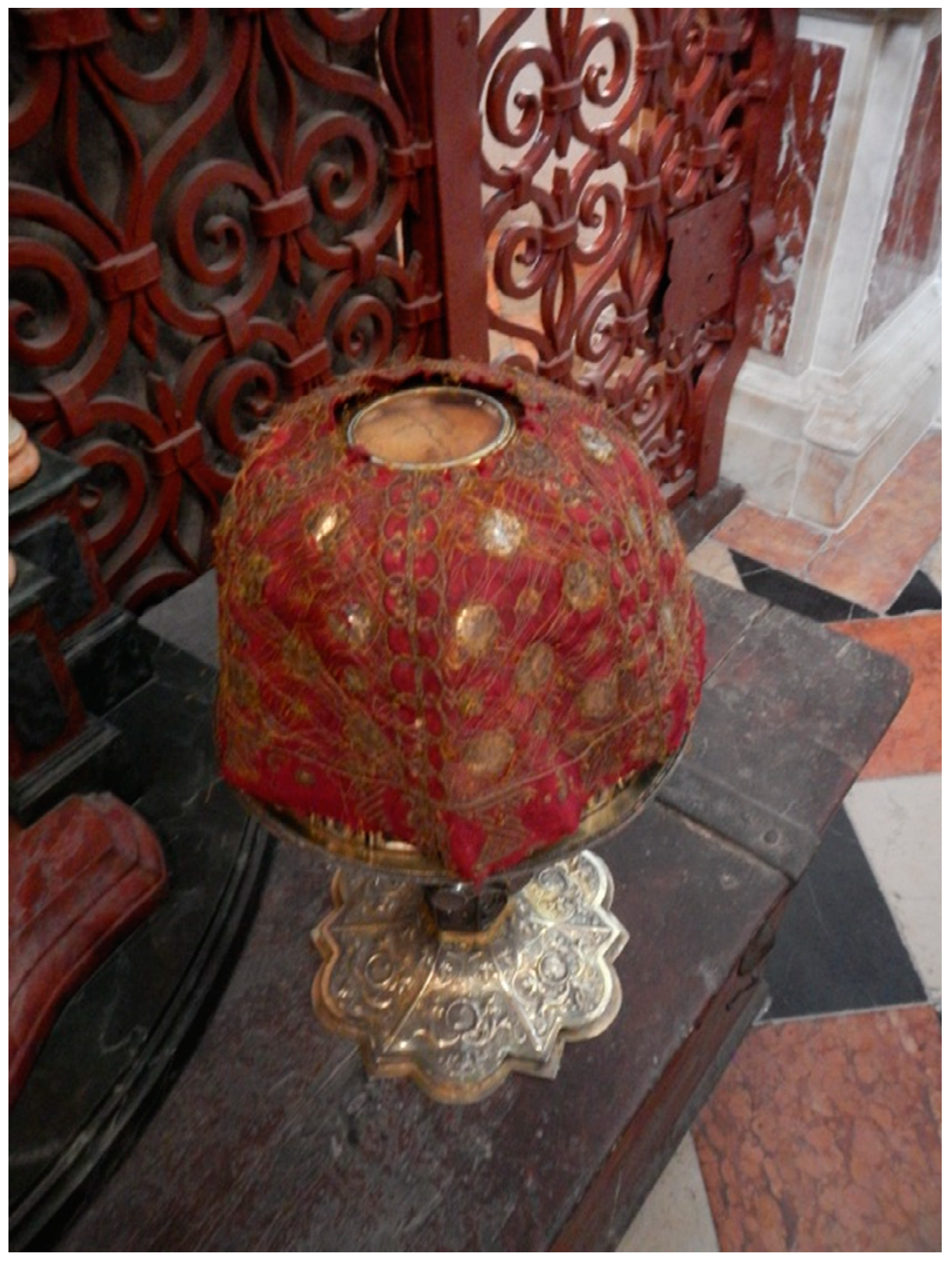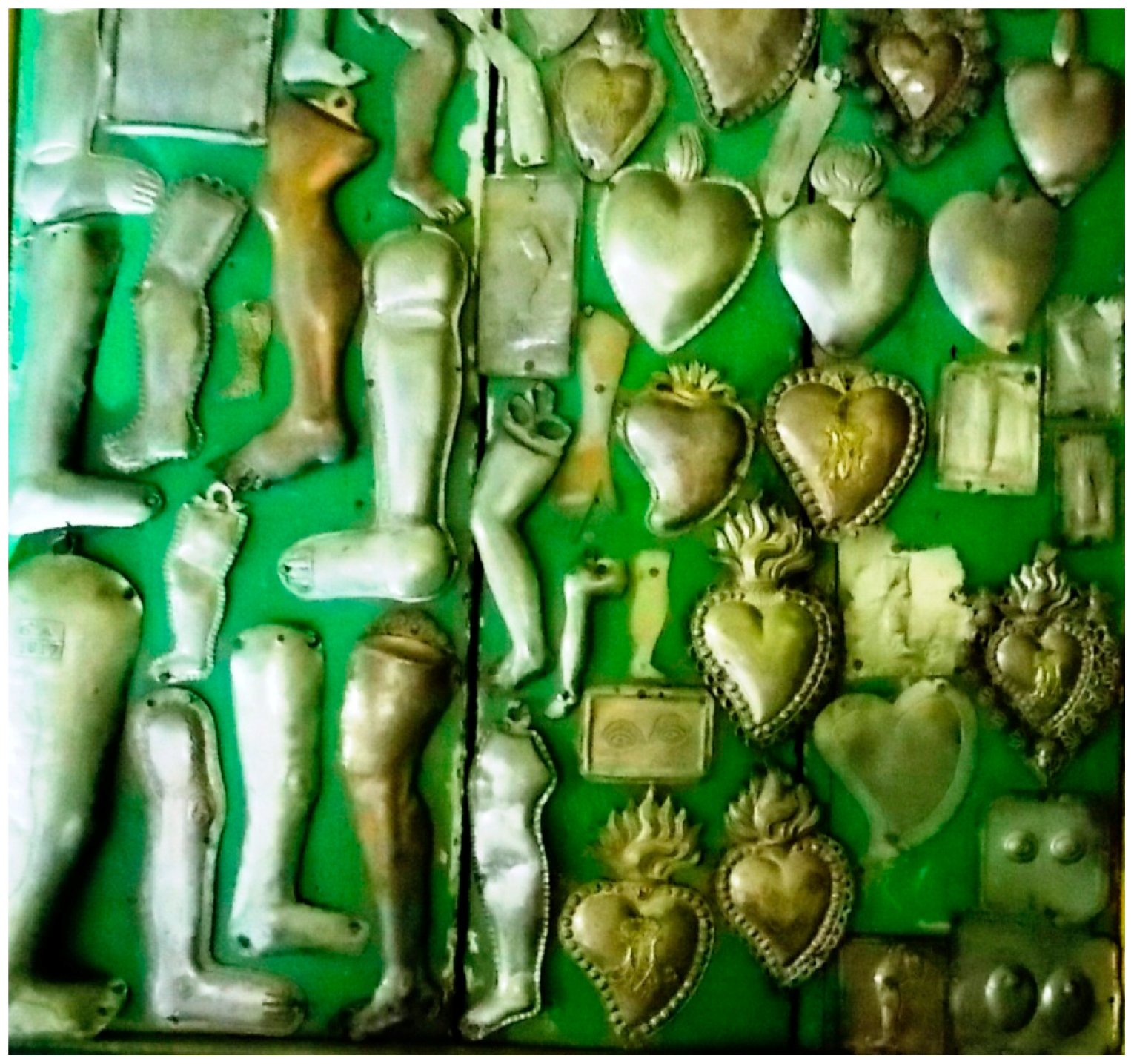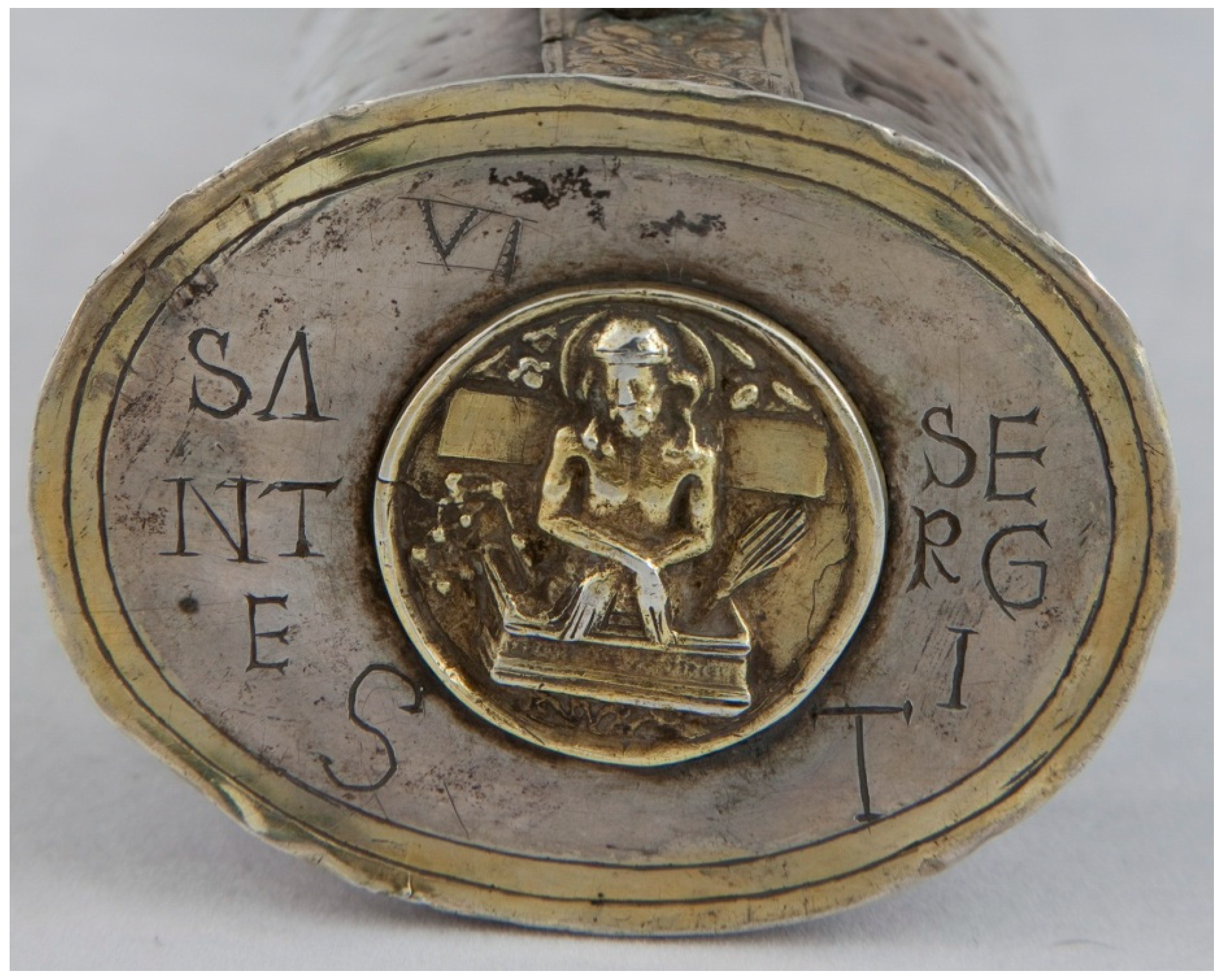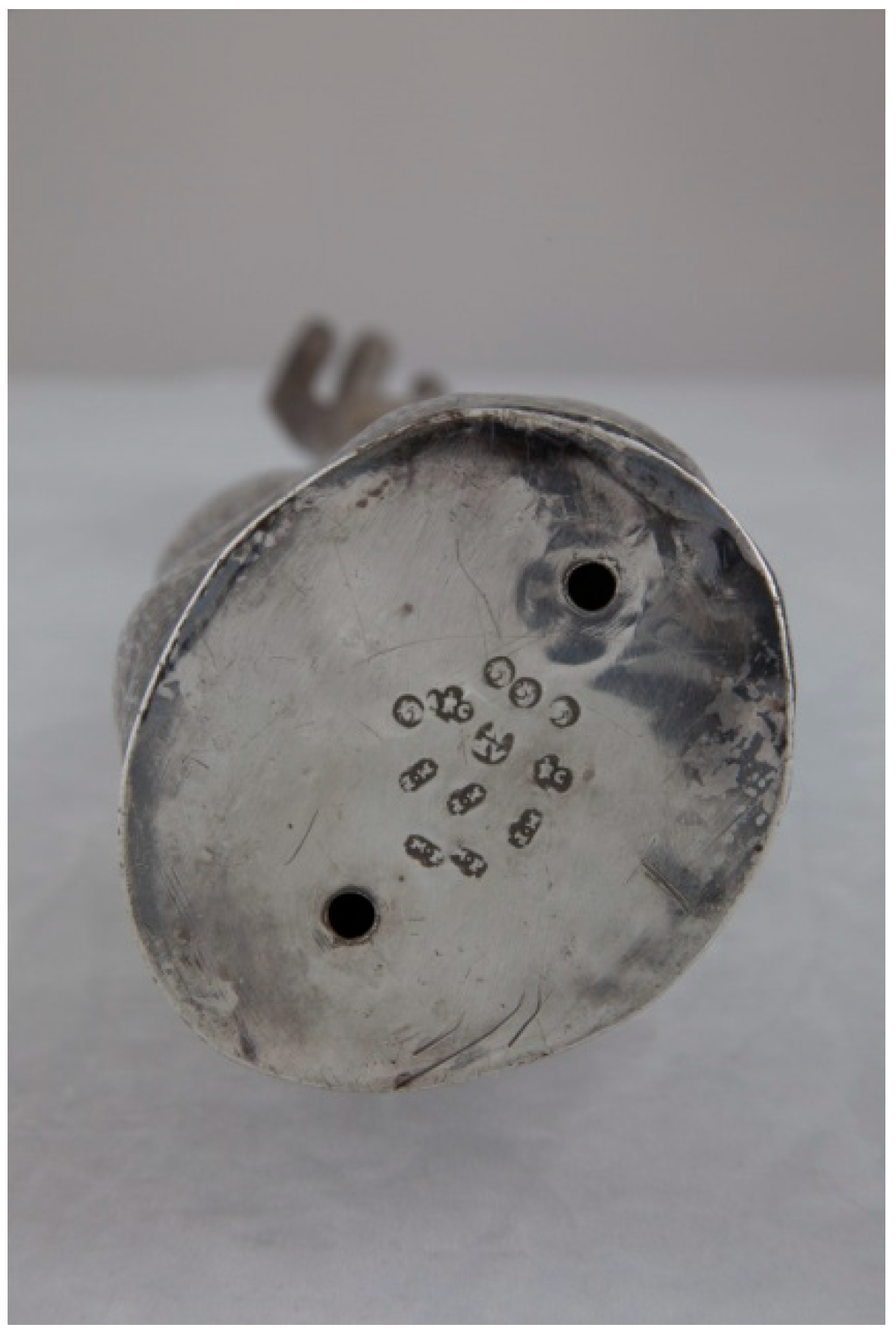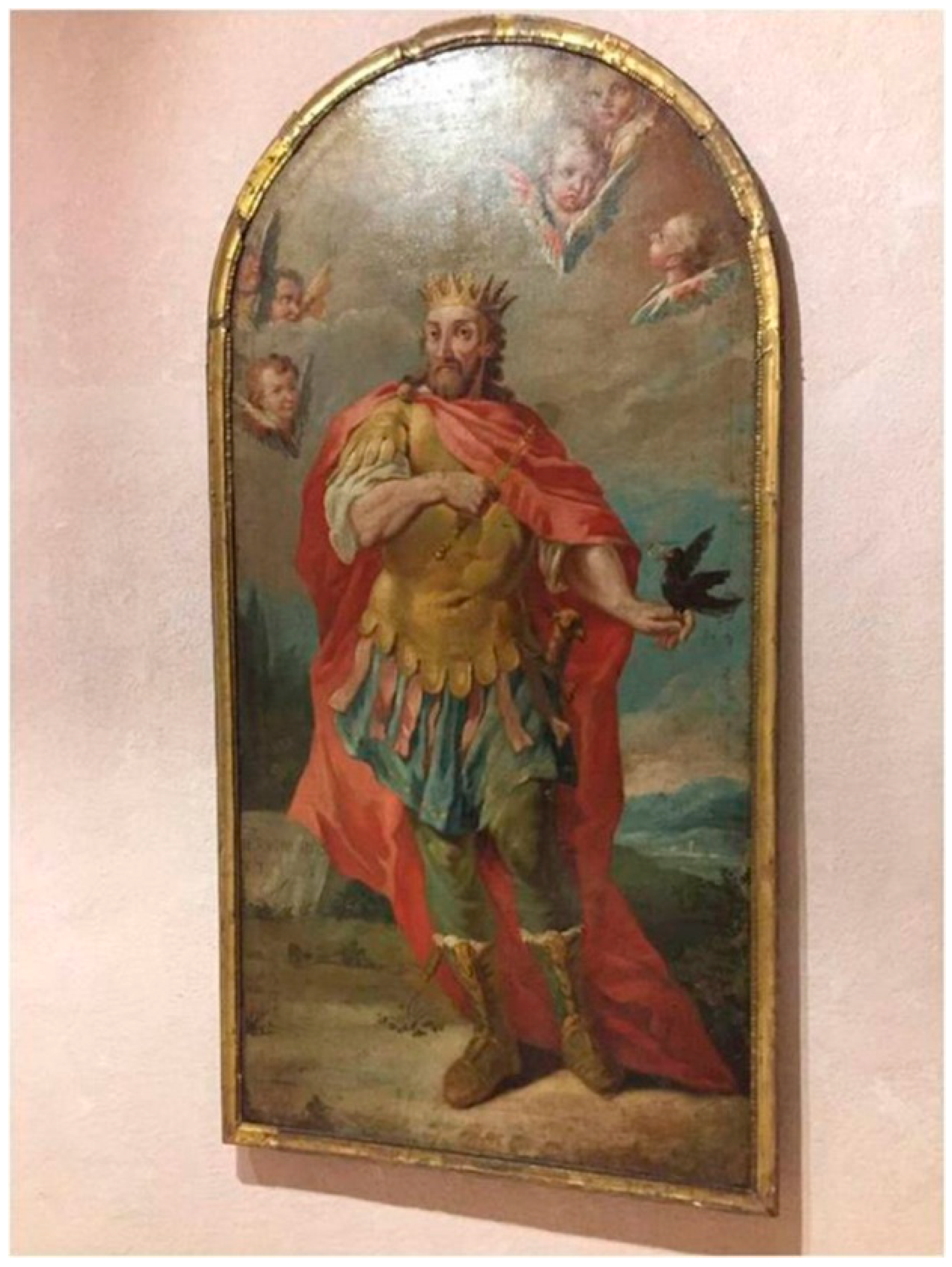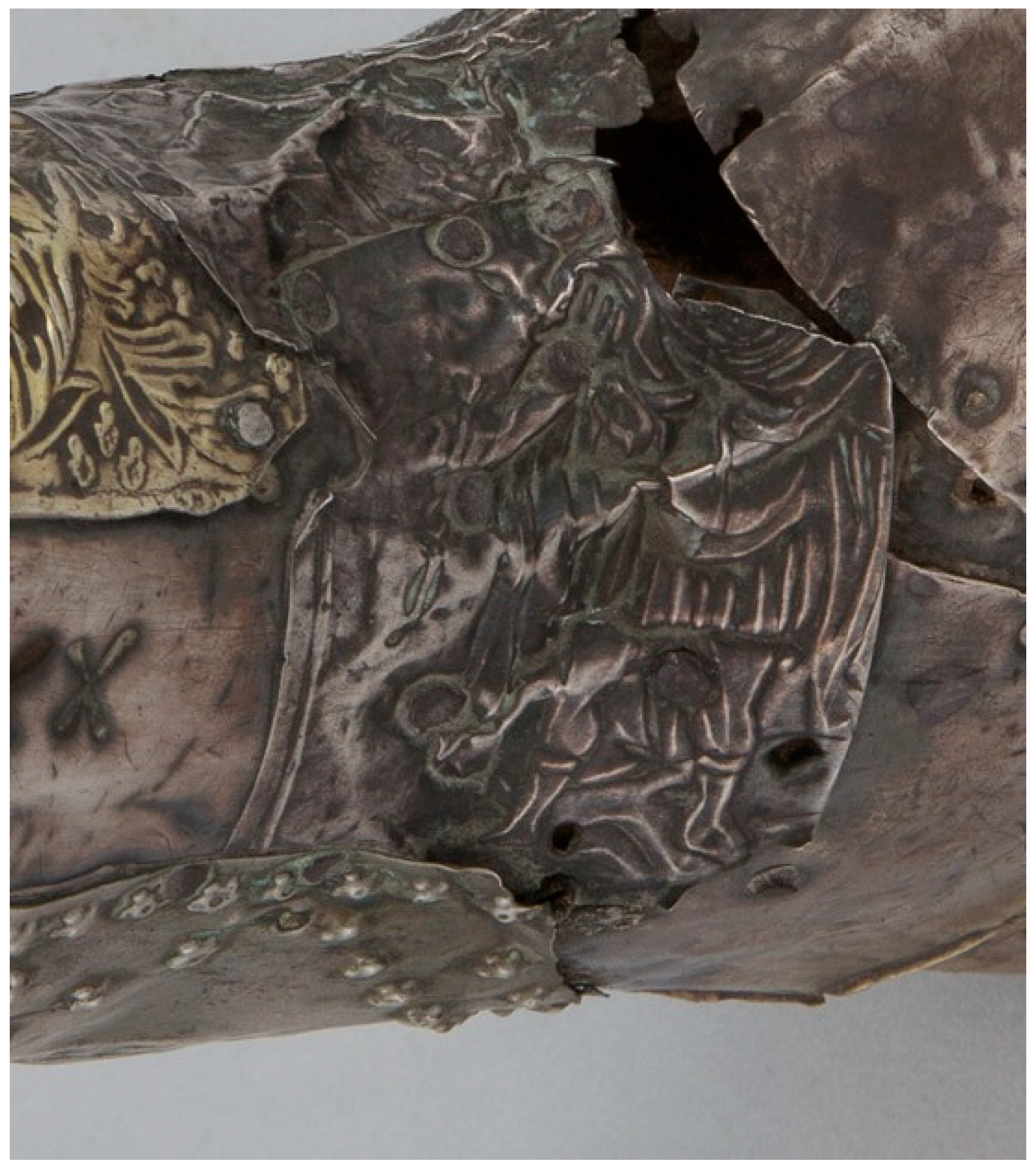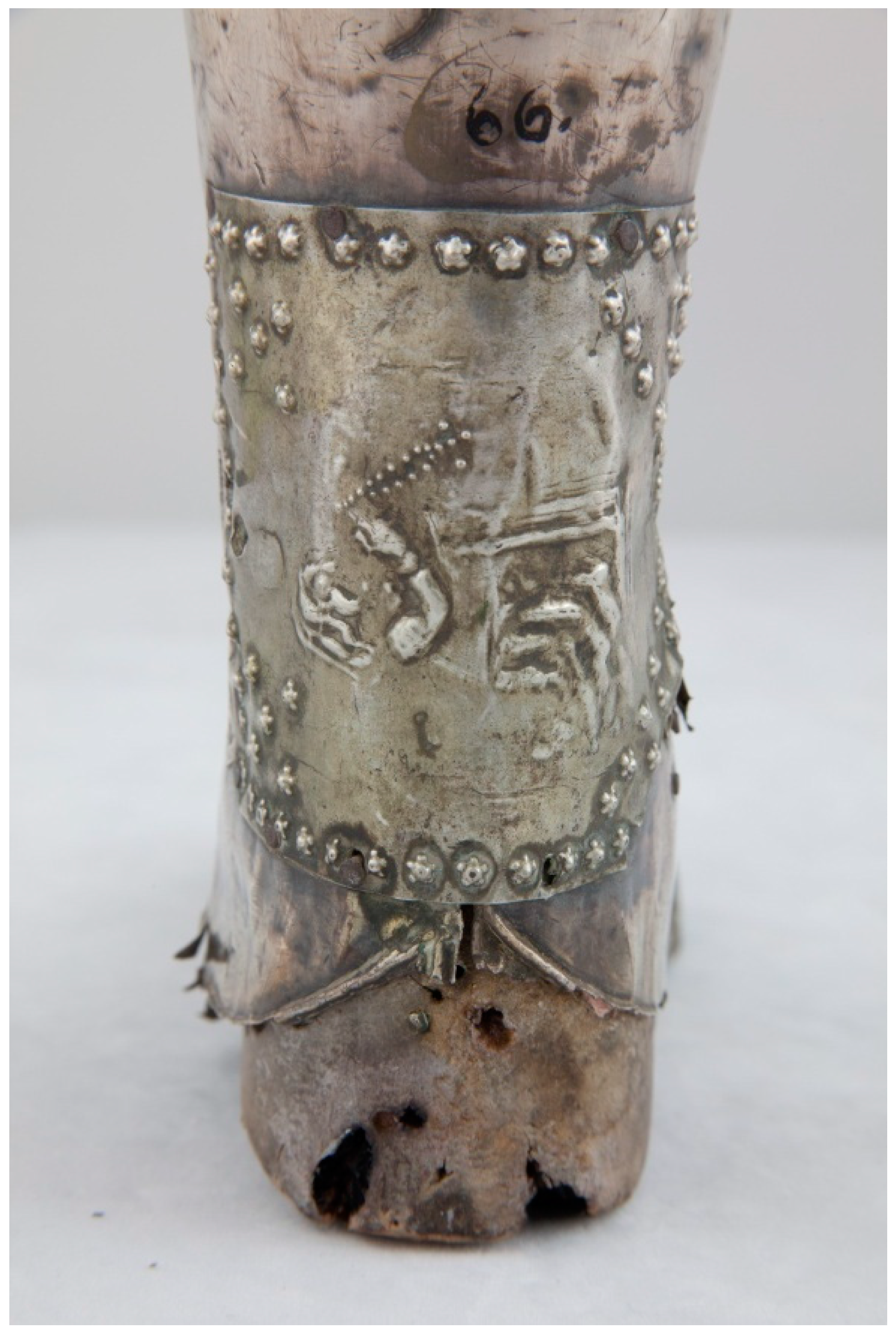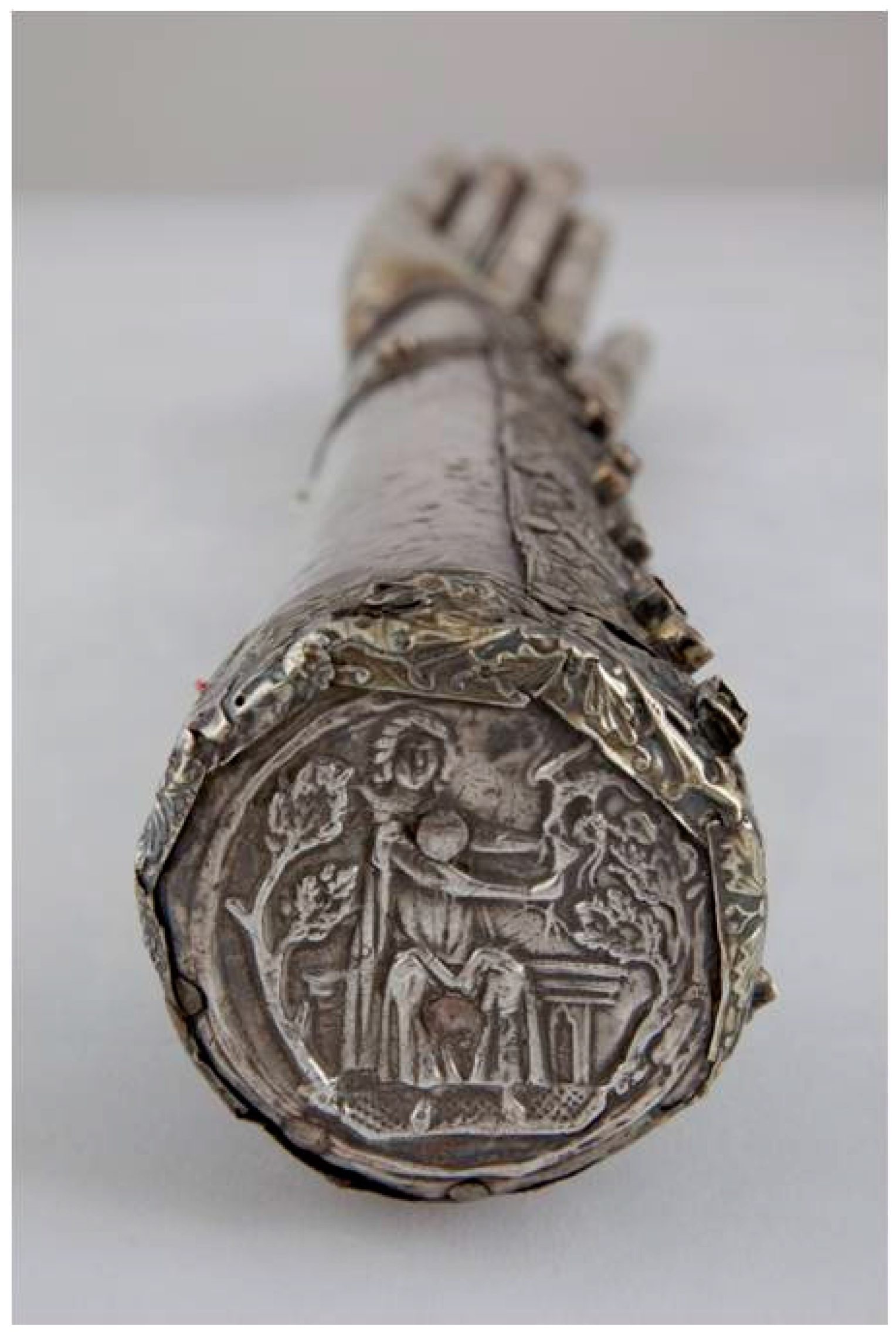2. Fragmentation of the Dead Body
During the 17th and 18th century, a significant number of sermons urged believers in the Bay of Kotor not to excavate and fragment the bodies of the deceased. They described this act as a practice that “had already made two priests abandon this area”.
1 Despite the condemnation, the excavation and fragmentation of bodies occurred regularly, and the people who engaged in it believed they were “being healed and saved from death”
2. As we learn from court records, men and women used bones and other parts taken from corpses for various rituals, which they performed at home to ward off everyday misfortune, sickness, and death. This domestic use of fragmented human bodies resembled the institutional treatment of saintly bodies. Both were treasured, used in rituals, and expected to offer protection in times of distress. However, to understand the significance of these “sinful acts”, we are required to examine the nuances that the process of bodily fragmentation signified for contemporary believers in the Bay of Kotor.
The focal point of fragmentation, seen from this point of view, was the relics in the chapel of the Cathedral of Saint Tryphon in Kotor (
Figure 1). Dozens of silver body parts—mainly legs, arms, and heads—have housed the bones of saints for centuries and are displayed on shelves around the casket holding Saint Tryphon’s remains (
Tomić 2009, p. 35;
Ulčar 2017, p. 6) (
Figure 2). During Saint Tryphon’s Day celebrations, these reliquaries were displayed in the church and carried in processions along the streets of Kotor, where common people could observe (and touch) the fragmented bodies of their patron saint and his entourage (
Stjepčević 1938).
3 The silver limbs and heads, which were always displayed as a group, offered an institutionally approved image of fragmented bodies. This was crucial for ritual and devotional acts in the early modern Bay of Kotor.
By contrast, the same act of dissolution was considered sinful when other kinds of bodies came into question. As the popular sacral play of this period recalls, during his suffering on the cross, Christ’s body was in danger of fragmentation. Missandro, one of the main protagonists in condemnation and crucifixion in Nenadić’s play, was determined to break Christ’s legs with a heavy mace and divide his body into pieces: “He should be cut/And ripped into pieces/Let them trusting (his Resurrection)/remain deluded!” Longinus opposed this suggestion strongly: “Great injustice would it be/to do that even to deceased!” (
Nenadić 1975, p. 266). The fragmentation of Christ’s body would result in the destruction of his identity. Had it been performed, he would have failed to fulfil his purpose. Bodies of saints, on the other hand, acquired power through an act that was similar, although usually less violent in nature (
Bynum 1991).
Examples seen in the “secular” life of people in the bay correspond to the aforementioned duality of fragmentation. In official terms, the domestic use of common people’s body parts was condemned. Popular 18th century catechisms by Antun Nenadić warned that excommunication awaited those who excavated corpses and desecrated deceased bodies (
Nenadić 1768, p. 113). Numerous sermons of the time reflect this sentiment: “And where are those hellish souls who with wickedness, just as infidels, viciously and cursedly open the graves and tear the dead body apart?” It was detailed how people would open the tombs and “tear the dead body apart or collect the pus from the corpse and apply it on the skin of the sick.” The same priest suggested perpetrators be banished “as one branch from the tree, cut from the goodness of the Holy Church.”
4 Therefore, the prescribed punishment for the fragmentation of deceased bodies was the excommunication of those sinners taking part in this dangerous act. The frequency with which similar statements appeared in sermons of the time indicates that the practice was widespread in the 17th and 18th centuries.
In 1630, a church tribunal in Venice accused a woman from Dalmatia of mutilating a male corpse. Two of her servants had allegedly helped her execute this sinful act. Her maid confessed that she had been forced to visit the graveyard two or three times: “
a pigliar una testa del mordo (…)
, un osso di homo, o di spalla, o di coste (…)” (
Čoralić 1998, p. 94). Once inside the household, they broke the bones with a hammer and performed rituals while uttering prayers. As will become clear later in this paper, people from different social classes resorted to manipulating the bones of the deceased to gain various benefits, with the healing of the body being the most commonly desired outcome. Concurrently, bones and particles of saints’ bodies were employed in a similar manner in churches and chapels. It is apparent that there was a need to maintain and conduct the same processes in the domestic setting, as well as relying on officially approved rituals. In addition to various herbs, “dragon’s leaking blood”, and “claw or hoof of a large beast”, an inventory discovered at Kotor’s old pharmacy also listed a tooth of Saint Nicholas (
Butorac 1999, p. 294). Particles of saints’ bodies were obviously used for medical purposes outside the jurisdiction of the church. Once again, fragmentation was tolerated when it came to the remains of saints, but objectionable when attempted or executed on Christ’s or “ordinary” deceased bodies.
More recent research reminds us that the concept of fragmentation of the holy body could be linked to another contemporaneous practice, wherein body parts considered criminal were put on public display as form of punishment (
Terpstra 2015, pp. 7–52). The mutilation of “criminal” bodies was allowed across Europe, and it would be of great scholarly interest to understand the parallel perceptions that occurred in the early modern believer, e.g., the image of a powerful silver limb of a saint in the church juxtaposed against the sight of a criminal’s rotting dismembered arm, leg, or head. However, as we learn from the archival materials, those kinds of punishments were quite rare in the Republic of Venice, at least when compared with other parts of Europe (
Seitz 2011;
Ostling 2011), and almost entirely absent from the Bay of Kotor. One exception occurred after a victory over the Ottoman army in Perast in 1654. The locals cut off the right arm of Mehmed Paša Rizvanagić, commander of the enemy troops, and sent his corpse to the Ottomans in exchange for slaves (
Krušala 1996, p. 220). Through this act, they desecrated Rizvanagić’s identity and humiliated his body by destroying its power and integrity. In 1538, a similar fate met don Carlo Gonzaga, Spanish commander of Herceg Novi, who was killed in retaliation for raping and murdering two young girls from Perast.
5 The townsfolk cut off his right arm and confiscated his sword, which is preserved in Perast to this day. In spite of the rareness of similar occurrences, fragmenting the enemies’ or criminals’ bodies in the Bay of Kotor, in contrast to their saintly counterparts, always brought disempowerment and harm to their identity.
Such acts of fragmentation implied harming an individual’s integrity, whether it was Christ on the cross, a defeated enemy, a common criminal, or a deceased neighbour. Tearing and cutting up the body brought humiliation, diminished its power, and endangered the prospect of life after death. And yet, when it came to relics and reliquaries, the fragmentation of bones and their placement into body-part containers was deemed a prerequisite for the opposite effect—one of gaining and distributing power and preserving identity (
Hahn 1997, pp. 20–31). However, the domestic use of “common” deathly remains should not be reduced to a mere consequence of these mixed messages about fragmentation and the preservation of body parts in the early modern bay.
Fragmentation was considered a powerful yet dangerous act. Dismembering an enemy’s body implied superiority and control acquired through victory over him. Missandro’s desire to tear Christ’s body stemmed from a similar motive. Both cases depict dismemberment and fragmentation as acts to relocate and gain power. Alternatively, body part reliquaries were always displayed as a group in chapels, church altars, and in the processional carrier along the streets. These particular types of reliquaries (as opposed to caskets, ostensory-shaped reliquaries, medallions, etc.) were meant to “work” together. To the early modern believer in the bay, they were always presented as a carefully orchestrated group of body parts, meant to create physical evidence for the concept of
pars pro toto. They gained their power through a metaphorical or performative integration with the whole, whether that was a saint in heaven or other reliquaries in the chapel (
Bynum and Gerson 1997, pp. 3–7;
Hahn 2010, pp. 284–316). Fragmentation and integration were considered two sides of the same coin, both of which were heavily co-dependent. The paradoxical (although theologically complementary) way of thinking (
Bynum 2012, pp. viii–455) allowed for this institutional practice to become desirable and, more importantly, translatable to the domestic setting. This fragmentation implied power, its distribution, manipulation, or relocation.
In his Catechism, Ivan Antun Nenadić explained that a soul inhabits every limb of the human body in the same way that Christ was present in every host and chalice in the world. When death occurs, the soul separates from the “bodily temple” and transcends from the earthly domain into the realm of God (
Nenadić 1768, p. 192). Nevertheless, various examples of post-mortem use of body parts in the early modern period point to a belief that human flesh and bones possessed power even after death. With veneration of relics, this belief was built upon the fact that the deceased person was holy and, as such, different from an “ordinary” human. The use of dead bodies was carefully orchestrated within the institutional context of church rituals. By contrast, manipulation of non-saintly corpses by common laymen was severely condemned. Numerous above-mentioned incidents testify that believers in the Bay of Kotor (as well as in other parts of the Venetian Republic) still excavated bodies of their neighbours from their graves and used the fragments in domestic rituals. This practice implied a strong conviction in the power of the human body to hurt or heal, even after death.
Katherine Park has argued that, during the late Middle Ages, Italians believed that “the corpse was only a corpse, the cast off of a self now definitely elsewhere.” Once the being no longer occupied the body, the corpse became a mere object, in contrast to Northern European beliefs, which held that deceased bodies were “a magical and semi-animated subject.”(
Park 1995, pp. 115, 125) Therefore, dissection practices, burial rituals, but also theological perspectives, greatly differed between these two regions. When it came to the post-mortem use and misuse of bodily remains, it was Northern Europeans who focused on powers that bodies obtained after death, not Italians. Non-saintly bodies, such as royal ones, were treated in accordance with that belief (
Đorđević 2017, pp. 1–19). In regard to the use of the “ordinary” human body after death, Michael Camille inspected the phenomenon of
mumia, a substance that was derived from corpses and consumed as a drug. During the late medieval and early modern period, parts of human corpses were widely used in traditional medicine, while the sick were supposed to be healed by ingesting these substances. However, this practice was thought to work by “direct natural, rather than supernatural or divine means.” (
Camille 1999, p. 312) Moreover,
mumia was always extracted from “pagan” corpses, obtained mostly from Egypt and Syria.
In the past, examination of dead bodies’ potential was usually illustrated through the examples of royal, pagan, criminal, or holy bodies. Once again, the “otherness” of the deceased (perceived either as an affirmative or a negative feature) was needed to create the belief that their corpses could influence the living. And still, in the Venetian Bay of Kotor during the 17th and 18th century, people dissected corpses of ordinary laymen. No archival source specified the identity, social class, or gender of the excavated bodies. It appears that the quality of other-worldliness was deemed enough to achieve the desired effect.
In contrast with Park’s hypothesis, the belief in the “semi-animated” corpse was still widespread in the southernmost part of the Venetian Republic, years after the Tridentine Reform. As already noted, in one of the aforementioned sermons, a priest urged his congregation not to collect pus from corpses. He mentioned how people used it “to apply it to the skin of the sick, or as protection from the deceased.” This warning illuminates how a “common” corpse could both cure the sick and protect the living from mortal danger. Corpses were understood, therefore, to simultaneously heal and harm.
As the archival records do not specify the identity of corpses used in “sinful” rituals nor detail the reasons behind this unorthodox concept, its influences should be sought elsewhere. One possible explanation could be found in popular beliefs that existed in Southeast Europe at the time. The Balkan peninsula was an area characterised by a dynamic exchange between Western and Eastern cultural codes. As such, the age-old beliefs in vampires and other kinds of “undead”, common in local folklore, could have influenced the use of bodily fragments within the private domain. Furthermore, from the 8th century onwards, the Bay of Kotor fashioned its identity as the “city of relics”, where most of the civic rituals revolved around the remains of Saint Tryphon, the town’s patron saint. The complex performative agency made the reliquaries and relics an integral part of everyday life for Kotor’s residents. The important role holy bodies played in times of distress, in combination with the vivid imagery derived from local folklore, could have contributed to the emergence of practices of unearthing and fragmenting of dead bodies. The belief that a deceased body could heal (and not only harm) the living likely stems from the same source as the relic veneration in the Bay. Visual and ritual methods of conservation and treatment of dead bodies were shared between official and unofficial domains. By assigning power to “ordinary” bodies and placing them in private domains, people from the Bay took control over this process, although always by mirroring established institutional practices.
The differing ways in which deceased bodies were used in either an institutional or domestic setting—although the latter was condemned—should be regarded as complementary, resting on opposite sides of the same early modern devotional coin. Laymen found creative ways to put into practice the knowledge they gained in institutional contexts. Their strong belief in the dogmas of the Catholic Church triggered an impulse to refashion its form, bringing them closer to their own world (
Arnold 2005). Domestication of institutional practices, despite being condemned as “magical”, “superstitious”, or “sinful” by church authorities, can be understood as a coherent part of the same religious mechanism. From this point of view, the fragmentation and use of body parts was widespread across various social settings. Despite existing within different contexts, it relied on a similar set of rules. Material objects used in these practices reveal a mirroring between the institutional and the domestic, official and popular, even orthodox and deviant.
3. Healing Using the Fragmented Body
In 1626, a woman from Kotor named Lucieta was accused before a church tribunal of performing acts of witchcraft, or
strigarie. As the case unfolded, it soon became obvious that not only Lucieta, but also several other women in the town were involved in the “
arte di Demonio”. The names Maria from Korčula and Mariza from Ragusa were often mentioned in the records, which described how these women had been healing children, men, and women in the bay.
6The town physician Francesco Grassi was called on to inspect the evidence found in Lucieta’s home. An object “in the shape of agnus dei” was found in the cupboard. Wrapped in red cloth, it held animal bones, blonde hair (strongly resembling that of Lucieta), children’s nails, and various types of wood of unknown origin (Vicentius Bucchia, pp. 916, 918). Additionally, it was revealed that Lucieta had given a cup of water to Maria from Korčula, which she was to serve to her master Vicenzo Bucchia. In the meantime, Lucieta was supposed to say “parole invocative di Dio” (Vicentius Bucchia, p. 920), i.e., the prayers that would complete the ritual. All three women were accused of healing children by witchcraft, a practice condemned by the Catholic Church, yet broadly accepted in the everyday life of its subjects. One witness even claimed that the women had been “doing the same for the whole town” and beyond, e.g., in the neighbouring villages of Orahovac and Ljuta (Ibid.).
The objects Lucieta used (bones, wax, body parts such as hair and nails, red cloth, and water) and the fact they were used in conjunction with rituals such as spoken prayers further elucidate the relationship between institutional and domestic devotion. Firstly, her “instruments” were stored with care, hidden in a cupboard and wrapped in red fabric. Secondly, they included specifically chosen materials, such as body parts, wax, water, and wood. Finally, they were utilised as tools in ritual performances with the aim of healing or eliciting benefits for herself and other citizens of the bay. The instruments employed in the secrecy of Lucieta’s home could be seen in a strikingly similar format and more institutional setting only a few streets away, at the Cathedral of Saint Tryphon.
The most important reliquary in the bay, the “Glorious Head”, containing the skull of Saint Tryphon, patron of the cathedral and protector of the town, has been treasured for centuries in the central part of the relic chapel (
Tomić 2009, p. 125;
Stjepčević 1938, p. 36) (
Figure 3).
The renovation of the chapel at the beginning of the 18th century formally replicated the earlier organization of the space (
Milošević 2003, p. 267). The silver casket with Saint Tryphon’s bones and the head reliquary were concealed in a marble box in the chapel. The entire space was enclosed with a large red iron grid, which had been recorded in the archives before the renovation. It was mentioned specifically in the 17th century, indicating that Lucieta could have witnessed its existence (
Tomić 2009, p. 170)
7 (
Figure 4).
Moreover, the cathedral inventory listed red curtains in the chapel, also evidenced by the red wrought iron hooks that lined its interior. It can be concluded that the bones of the most important saint in town were carefully stored and locked in a casket, and then fenced off with an iron grid and covered with red curtains. Furthermore, the head reliquary, ritually held in processions, was wrapped in precious red cloth and hidden from the view of the common people for the remainder of the year (
Figure 5).
On 3 February, Saint Tryphon’s Day, as part of the complex ritual celebration and manipulation of the relics, this reliquary was washed with water, which was then preserved and later used by nuns, as it was believed to be capable of healing the sick.
8 Ritual washing of the head using water as a precious and powerful substance, along with spoken prayers and the kissing of the reliquary, was the focal point of celebration for the common people. This was the sole instance in the liturgical year when direct physical contact with the saint was institutionally approved. In addition to being washed with water, the reliquary was dried with linen cloths attached to tiny candles. After the ceremony, these would be treasured by believers “until the hour of their death”.
9 Water and wax candlesticks, the objects that remained after the celebrations were over, were kept in the households of common people as precious contact relics.
The physical evidence found in Lucieta’s cupboard reveals the profound influence that institutional practices had on the common people. Since the possession of saints’ bones was a privilege reserved for religious institutions and wealthy citizens, she replaced them creatively with different kinds of corporeal elements obtained from animal carcasses and even living human bodies, including her own. The use of the fragmented body, along with the particular ways in which it was preserved and manipulated in healing rituals, was Lucieta’s way of controlling everyday life, something she achieved by replicating institutional forms of devotion.
Witnesses confirmed that the two other women, Maria and Mariza, used a similar performative framework in their “witchcraft”. Maria was rumoured to be a witch because she healed “children, women, and men” by using herbs and “saying sacred words”. Mariza used “certain oils” to heal children while saying “various prayers”. A male witness confessed that she had healed his impotence by giving him a remedy for “
poter ussar carnalmente con le Donne”.
10The use of oils, water, bones, wax, or wood particles in combination with sacred words and prayers was how the three women performed healing across the Bay of Kotor. The evidence of treasuring material objects for use in “witchcraft”, in the case of Lucieta, further illuminates the dynamic relationship between the official and the private. After deciding to take control of the healing process, these women simulated and appropriated knowledge that had been gained in an institutional context. It had been proven repeatedly that the fragmented bodies in the relic chapel and the church were potent. Lucieta decided not only to relocate that power by translating it to her private household, but to do so by following the rules of presentation and animation as prescribed by the church authorities; for example, by using the colour red, treasuring the bones by wrapping them in cloth, and securing them in a concealed place in her home. Their animation was triggered through the utterance of sacred words and usage in combination with other materials believed to be sacred and potent, such as wax, wood, and water.
4. Healing the Fragmented Body
In 1667, forty years after Lucieta’s misdeeds had been brought to light, a massive earthquake caused severe damage to parts of the Cathedral of Saint Tryphon, including the relic chapel. Numerous silver body part reliquaries were broken. Archival material holds evidence detailing efforts to overcome the devastation caused to the sacred objects. Among the donors was nobleman Radeta Chiapechi, who bequeathed part of his funds to be used annually for repairs to two reliquaries in the cathedral (
Tomić 2009, p. 122). However, the archival document offers no description of the exact manner in which repairs were conducted. Fortunately, physical proof of these efforts is still present in Kotor’s cathedral, although it remains hidden inside the cupboards of the relic chapel, as opposed to being displayed on the shelves of the cathedral’s Museum of Sacral Art.
Taking into consideration important research on animation (
Bynum 2011, pp. 25–31), as well as the complex nature of reliquaries, which were seen as objects
and subjects by contemporary observers (
Hahn 2005, pp. 239–63), I would like to propose the concept of
healing—as opposed to
repairing or
fixing—the physical damage caused by the earthquake to these sacred containers. Caroline Walker Bynum, in her highly influential study on Christian materiality, argues that not only did medieval devotional objects point beyond their own materiality, but also deliberately disclosed their “stuffness” to the beholders. Their problematic nature led to simultaneous proliferation and occasional iconoclasm. Both hostility and enthusiasm, thus, could be found in the attitudes of the church authorities and theologians toward different forms of holy matter. All those numerous oppositions have grown from the powerful and problematic assertion that matter was experienced as organic, fertile, changeable, and, most importantly, alive. This basic understanding of matter, shared between different social classes, although present during the previous centuries, was mostly found in later medieval phenomena. (
Bynum 2011, pp. 35–40). When it comes to post-Tridentine attitudes toward the
living matter, the circumstances remained problematic, although church authorities continued to warn against the “wrong” beliefs. Nenadić in his catechesis reminds the congregation that “the image does not hear our prayers, but those who are depicted there do” (
Nenadić 1768, p. 111). However, during the 17th and 18th century, believers in the Bay of Kotor continued to treat devotional objects, and especially reliquaries, as if they were alive. The sacred composite of relic and reliquary was referred to as an animated (or at least semi-animated) substance. The skull of Saint Tryphon in its lavish reliquary was called the Glorious Head. The arm reliquary of Blessed Grazia bears on its skin the carved inscription “Il brazo di Beato Grazia” (The arm of Blessed Grazia). The semiotic inseparability of relics and reliquaries enabled relentless belief in the animated nature of the powerful composite. Reliquaries took on properties of the very things they contained, becoming “both subject to and the object of sacred contagion” (
Klein 2015, p. 233). Therefore, the physical repair that broken objects endured after the earthquake in Saint Tryphon’s cathedral took the form of the process of healing that injured individual went through inside the walls of domestic space.
The practice of “healing” these broken limbs sheds light on the ways in which institutional efforts simulated certain principles of private devotion, mirroring previously presented examples, which illustrated the process in the opposite direction. Several body part reliquaries from Kotor feature small, silver ex-voto plates on their surfaces, which were used as patches to cover cracked skin or missing parts. These odd-looking objects prompt the question: Why were silver votive plates used to undo the harm inflicted on the reliquaries?
In the 17th and 18th century, silver was widely used and, therefore, was visibly prominent in the churches of the bay. A great number of icons were adorned with silver casings and lit by candles inserted into large silver candlestick holders. The Cathedral of Saint Tryphon had, among other treasures, an entire altar made of silver (
Butorac 1999, p. 290). The reasoning behind the use of ex-voto plates in the “healing” of the reliquaries should not be reduced to a pragmatic explanation such as a lack of other materials or the convenience of using silver for these particular shapes. Since the reliquaries were highly valued and carefully protected as the cathedral’s most precious treasure (
Stjepčević 1938, p. 13)
11, any argument that implies ignorance or negligence on behalf of their guardians should also be dismissed. To answer the question posed above, it is useful to delve deeper into the function and role these plates acquired once they were removed from the walls and reused as parts of holy limbs. In the early modern era, donating an ex-voto plate after surviving an ordeal such as a shipwreck, enslavement, or sickness was common practice (
Jacobs 2013;
Didi-Huberman 2007, pp. 7–16). As a result, the walls of churches in the bay, especially the island church of Our Lady of the Rocks (Gospa od Škrpjela) in Perast, were covered in hundreds of silver plates depicting cured legs, arms, eyes, torsos, or breasts (
Brajović 2006) (
Figure 6). Others portrayed praying figures, various saints, ships caught in storms, or chained men praying before an icon.
On reliquaries, the majority of ex-votos were found on round surfaces on the top or at the bottom, depending on whether the plate was added to an arm- or leg-shaped container. This particular placement has its own micro history, which can be traced back to the medieval period.
It is important to note that this miniscule area of the object was not visible to the beholder, neither in the relic chapel nor during a procession. If we compare late medieval and early modern examples, we could draw the conclusion that this particular spot served a similar purpose, even when differences in visual vocabulary and form are taken into account. It was used either for inscriptions or figural representations, which is why many of them bear the figures of saints or saints’ names. Furthermore, representations of Jesus, the
Arma Christi, or Christograms were commonly displayed during the early modern period (
Figure 7).
These round spaces also contained the names or coats of arms of donors or those of the artisans and silversmiths who made the reliquaries. During the early modern period, artisans’ names were also accompanied by the stamps of their workshops (
Figure 8). It can be assumed that the function of this tiny silver spot was twofold. It could have been a medium used to enhance the object’s sacred power by adding an image or the name of a holy person, or a prominent votive dedication through which artisans or patrons recommended themselves to God.
In some cases, the ex-voto plates that replaced the original parts of damaged reliquaries replicated the same iconographic scheme. A few of them featured representations of holy figures, such as the Virgin Mary or various saints. These depictions could be classified as motifs that served to emphasize continuity with their medieval neighbours—the image of a holy person whose task was to empower the object as a whole. More provocative, however, was the choice of votive plates that depicted the praying figures of donors. On the votive plate placed at the bottom of one arm-shaped reliquary, an anonymous man is seen praying to the figures of the Virgin Mary and a saint who is wearing military garments and holding in his left hand a bird with a ring in its beak (
Figure 9).
This rather unusual iconography for the early modern Bay of Kotor proves less exotic once the second figure is identified as a saint whose portrait is currently housed in the Cathedral of Saint Tryphon’s Museum of Sacral Art: Saint Oswald of Northumbria, a 7th century British ruler who united two kingdoms of the British Isles.
The painting likely dates to 1700 and is the work of Giovanni Venanzi, a lesser-known Venetian artist (
Tomić 2005, pp. 14–16) (
Figure 10). The particular iconography seen in the portrait is explained by events in the saint’s vita: the raven was used as a mediator between the king and his bride, carrying the ring in both directions (
Giampietro Della Stua 1769). It could be that this painting was used as the model for the figure on the plate. In his right hand, Saint Oswald holds a sceptre, which can be discerned on another votive plate, placed not on top or at the bottom of the silver reliquary, but on the main surface. Although severely damaged, the saintly king in military attire can still be distinguished (
Figure 11). On the same leg-shaped reliquary, another votive plate is used as a “patch”, depicting a figure kneeling and praying with rosary beads (
Figure 12). A similar relationship of an anonymous layman praying to the saintly king is visible on both objects, although creatively combined using separate ex-voto plates on the leg-shaped reliquary. The third example, originating from the same treasury, bears a peculiar depiction of a young nobleman with, once again, a bird and a ring (
Figure 13). Although likely dating to the late Middle Ages, this metalwork is attached to the top by visible nails, suggesting it could have been added to the medieval reliquary later. However, this particular silver “patch” differs in nature from the other examples mentioned and it is probable that this image was not meant to have a votive purpose. On the other hand, its function and familiar iconography, not dissimilar to the depictions of Saint Oswald on other votive plates, could very well place it within the same group of ex-votos.
This iconographic clarification only complicates the question posed earlier. Is it possible that Venanzi’s late 17th/early 18th century painting triggered a cult of Saint Oswald in Kotor and that votive plates were offered to this particular saint? Even more curious is the reasoning behind the repeated use of Saint Oswald’s image on damaged reliquaries in the cathedral. His Northumbrian hagiography can hardly be related to Venetian Kotor. There were no other votive plates with similar iconography recorded in churches in the bay, nor were comparable objects mentioned in archival material or secondary literature (at least to the author of this paper’s knowledge). Saint Oswald’s nearest and most developed cult was in Sauris, located in Friuli Venezia Giulia, which was at the time ruled by the Republic of Venice (
Grassi 1782, p. 170). The church of Saint Oswald was a centre of pilgrimage during the 17th and 18th century. As we learn from the notably scarce sources, this particular saint was venerated across the Republic of Venice as a protector against disease. More precisely, he was often invoked as “saint protector of bones”. Unfortunately, the physical findings of his cult remain insufficiently researched. It is known, however, from contemporary pilgrim sources, that the saint was famed for the successful and quick healing of damaged bones.
12If we recall that the reliquaries were not only instruments for treasuring the memory of saints, but themselves dynamic and present subjects throughout the past centuries, it can be argued that healing them required a process more complex than the mere fixing of cracks caused by an earthquake. The application of votive plates to the epidermal layer of broken reliquaries, together with the choice of a saint responsible for healing disease and broken bones, could lead this interpretation to the topics of animation and subject–object relations. However, this phenomenon might also offer a deeper insight into the role that “domestic” or “private” processes for healing the “ordinary” body occupied in the creative refashioning and treatment of saintly bodies in the institutional setting. As dozens of silver ex-voto plates in the bay testify, the men, women, and children of households prayed before an icon for their loved one to be healed in times of sickness. Some plates feature miniscule representations of families, united around the bed of an ailing family member, kneeling and praying under an icon of the Virgin Mary or another saint. Other plates render single body fragments—leg parts, arms, breasts, or eyes—as evidence of healed body parts. Some depict a saint or praying figure as crucial elements in the act of receiving heavenly aid. The most common timeline for the process would have been: suffering; praying to the saint; healing; donating the votive plate. Through the final element in the chain, a process that largely takes place within the domestic space of the injured person suddenly becomes part of the institutional setting (
Laven 2016, pp. 191–212). As such, silver votive offerings incorporated features of both private and public devotion.
When it comes to their application to body-part reliquaries, the timeline mentioned above, which assumes a gradual process of miraculous transformation, is replaced with an instantaneous change. From the point of iconography, these composite objects—reliquary with votive plates attached—required the presence of praying figures, patron saints of the sick, and the newly cured limb. In this case, the healing was performed by integrating an object that represented aid successfully received, one that held the power of the holy presence in the everyday world. The choice of Saint Oswald, a sacred figure celebrated for curing the diseased, especially those with injured bones and limbs, conforms to the popular image of a reliquary that simultaneously involves components of the object and subject. The praying figures and the presence of carefully chosen saints were needed to affect the “subject” part of the sacred composite. Applying newly forged silver plates as “patches” rather than pre-used but more evocative ones would leave us in no doubt about the clear-cut separation of the two spheres within the institutional setting after the Reformation. However, treating the reliquaries as animate matter shows the existence of highly complex attitudes in early modern (official) devotion to the saints. Most importantly, in times of distress, the church authorities, which had to approve every contact with the reliquaries in the chapel, chose a mechanism of healing that reflected the private lives of believers. They treated the injured saintly body the same way that loved ones treated their sick family members or themselves, by using elements already familiar—from images of saints and rosary beads to performing the act of kneeling and praying, and, finally, offering a votive gift as testament to the successful end of the journey. The body parts of saints, who for centuries assisted in healing and protecting believers in the bay, were themselves healed by simulating procedures usually performed in a domestic setting, even though that was sometimes done by using fragmented bodies other than those of the saints.
5. Conclusions
The domestic use of fragmented bodies for the purpose of healing was a consistent practice in the early modern Bay of Kotor. Instead of relics and reliquaries, common laypeople used the remains of deceased people acquired through the risky practice of grave exhumation. Others, such as Lucieta, used fragments of living bodies and animals. When questioned before a church tribunal, both the accused and witnesses emphasized their strong belief in God, which they supported by stating that they attended church regularly and took communion twice a year. The “sinful acts” that resulted in their condemnation, in terms of iconographic and performative elements, bore a strong resemblance to the institutional treatment of the fragmented bodies of saints. On the other hand, institutional efforts to repair damaged reliquaries, with the use of particular iconography and votive plates, mirrored the way in which the injured bodies of common laypeople were healed in the private domain. When a body needed to be protected from illness and damage, both parties from the different sides of the border separating the “official” and “unofficial” domains of religion reached for tools that had proved effective in yielding the desired result. By borrowing and adopting iconographic and ritual elements from each other, the church authorities and common people participated in a shared devotional world in which the fragmented body and its creative (mis)use possessed healing powers.
The examples of creative exchange in ways of healing the sacred and the ordinary human bodies, where official and private practices existed on a continuum rather than as opposites of orthodox and heretical, could be seen as a fruitful ground for further methodological treatment of similar subjects. The lack of archival data on domestic practices could be complemented, although carefully, by the existent knowledge of institutional manipulation of the body (and vice versa), allowing for the more flexible approach to the matter. Dissolution of clear bynaristic methodological structures should not leave the researcher on a shaky relativistic or pluralistic ground of postmodernism with the fear that following any particular direction would only mean creation of another fixed narrative. In this case, allowing the spectrum or continuum of religious practices, instead of familiar binary model, does not imply the lack of (always artificial) methodological symmetry. However, the ways in which domestic and institutional attitudes toward the body intersected are various and rather complex. In this paper, the chosen methodological path has followed usage of the fragmented bodies in the two domains, merging them into the vast research ground, and denying the firm line of division. In that manner, diverse historical subjects (the witch and the priest, among others) were allowed to communicate their realities as equals, in spite of differences in verbal and visual vocabularies that were both used for the purpose. Moreover, the articulations of the healed bodily image that each offered were treated as equally influential, allowing for the ideas to flow in both directions. In that way, fragmentation and healing, as the focal points in this analysis, proved to be flexible and adaptive concepts, similarly used in both official and domestic surroundings.
